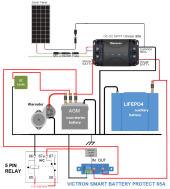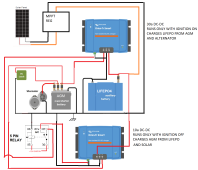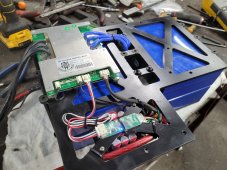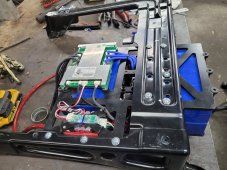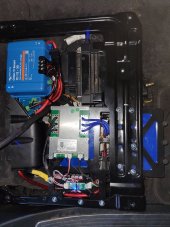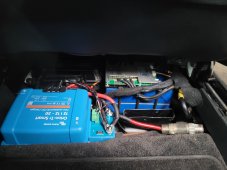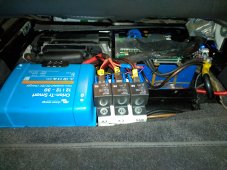I am after some inputs from the pro's on a proposed hybrid AGM/LIFEPO4 setup for my 4x4.
All the loads i want to run for camping are already wired off the main 105ah factory AGM battery and I don't want to rewire everything for them to run off the aux battery.
The idea is to keep everything running off the AGM and use the Li to top up the AGM as power is consumed. Basically the Li is acting as a charger for the AGM.
The Li bank will be 4 x 105ah prismatics and a 100a JBD or Daly BMS.
Alternator is 190a, water cooled.
With the engine running, the Renogy 50a DC-DC charger will charge the Li with the correct parameters and will even lock out charging at low temps (we never see below freezing here anyway), while the alternator charges the AGM. The 5 pin relay is supplying no power to engage the Victron battery protect so the Li is charging only - no load.
With the engine off, DC-DC will disconnect itself and the 5 pin relay will engage the battery protect. At this point the Li should start trickle charging the AGM at around 13.6v until it runs out of juice, at 12.0v the battery protect will cut out to protect the cells. I guess at some point in the voltage curve there isn't enough volts to trickle charge anymore and it will start drawing power from both batteries. When the batter protect disconnects the lithium at 12.0v, i guess the AGM is at 50% SOC and needs charging too. But will still easily have enough juice to start the car.
While the engine is off, the Renogy should take input from the solar and charge the Li first, then the AGM if the Li is full.
Any suggestions? I can always change the battery protect for a small Victron DC-DC converter or charger but both increase the cost and I am not sure if they offer any real benefit.
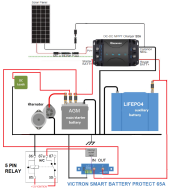
All the loads i want to run for camping are already wired off the main 105ah factory AGM battery and I don't want to rewire everything for them to run off the aux battery.
The idea is to keep everything running off the AGM and use the Li to top up the AGM as power is consumed. Basically the Li is acting as a charger for the AGM.
The Li bank will be 4 x 105ah prismatics and a 100a JBD or Daly BMS.
Alternator is 190a, water cooled.
With the engine running, the Renogy 50a DC-DC charger will charge the Li with the correct parameters and will even lock out charging at low temps (we never see below freezing here anyway), while the alternator charges the AGM. The 5 pin relay is supplying no power to engage the Victron battery protect so the Li is charging only - no load.
With the engine off, DC-DC will disconnect itself and the 5 pin relay will engage the battery protect. At this point the Li should start trickle charging the AGM at around 13.6v until it runs out of juice, at 12.0v the battery protect will cut out to protect the cells. I guess at some point in the voltage curve there isn't enough volts to trickle charge anymore and it will start drawing power from both batteries. When the batter protect disconnects the lithium at 12.0v, i guess the AGM is at 50% SOC and needs charging too. But will still easily have enough juice to start the car.
While the engine is off, the Renogy should take input from the solar and charge the Li first, then the AGM if the Li is full.
Any suggestions? I can always change the battery protect for a small Victron DC-DC converter or charger but both increase the cost and I am not sure if they offer any real benefit.




